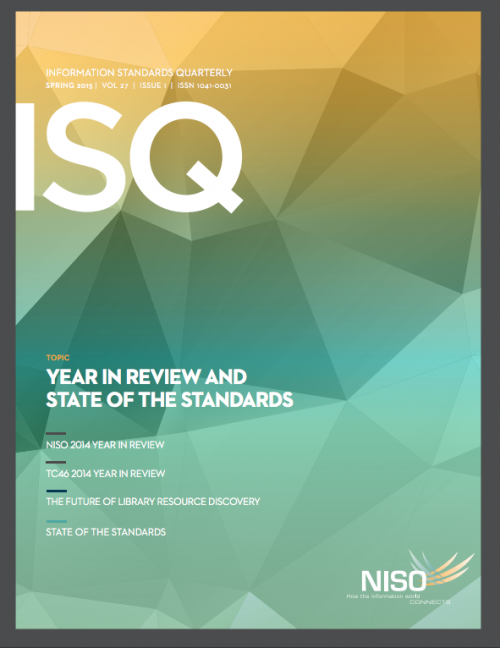Information Standards Quarterly, Spring 2015
Letter from the Editor
Each year, we focus the first issue of ISQ on documenting the previous year’s successes and recap the work accomplished. NISO continues to make significant strides in making information distribution more efficient and functional. Simultaneously, we bring older standards up to date, while also working on newer, even cutting-edge information exchange issues.
We so often forget about maintenance and upkeep of the infrastructure elements that were developed years ago. Old reliable stand-by services and processes might be widely adopted and applied. But as with all things, they begin to degrade over time, needing reconsideration and revision to ensure that they remain fit for purpose and viable in an evolving ecosystem. This is certainly true for a variety of specifications that were reviewed, updated, and advanced in the past year. NISO revised the SUSHI standard, the COUNTER-SUSHI Implementation Profile, and the KBART recommended practice. NISO also initiated its first stabilized standards. Stabilized maintenance removes a standard from the requirement for five-year periodic reviews. It is used for standards that address mature technology or practices and are not likely to require a revision.
While maintenance of our portfolio is an under-appreciated activity, the development of the “shiny and new” remains a focus of our work as well. I have been particularly pleased with the growing leadership role that NISO is carving out in our community in areas such as promoting transparency in library discovery services, demand-driven acquisitions of monographs, metadata indicators for access and licensing, and web synchronization of digital resources— recommended practices and standards that were published in 2014.
Key among these efforts to push forward the state of the art in our community has been the continued development of work in the field of assessment. With the generous support of the Alfred P. Sloan Foundation in late 2013, NISO launched a project focused on new forms of assessment. The project finished up the brainstorming Phase I in June and subsequently led to the approval of five new development efforts that are set to begin in 2015.
2014 was a momentous year in many respects. The Organization celebrated the 75th Anniversary of its foundation in 1935 as the Z.39 Committee of the American Standards Association. We held a small reception at the American Library Association conference in Las Vegas celebrating this achievement.
For the first time in more then a decade NISO hosted the plenary meeting week of ISO’s Technical Committee 46 – Information and Documentation. Under the auspices of ANSI and with the generous support of the Library of Congress and the National Archives and Records Administration, NISO brought together nearly 200 delegates from more than 40 countries for a week of meetings. The week was capped off with a gala dinner in the Rotunda for the Charters of Freedom at the National Archives. Archivist of the United States, David S. Ferriero participated and introduced keynote speaker Vinton Cerf, one of the key developers of the internet. It was a very special evening highlighting the work of ISO, NISO, and information distribution in our digital age. It was also a pleasure to take a moment to honor all those who have contributed to our success over these past three quarters of a century.
Speaking of honoring those who have played a role in our success, I would be remiss if I did not acknowledge the many contributions of Cynthia Hodgson, the Managing Editor of this magazine, as well as of NISO’s monthly newsletter Newsline, and editor of all of NISO’s standards and other publications. Cynthia announced her retirement earlier this year and this will be the last issue she will manage. I can hardly overstate Cynthia’s contributions to NISO’s work over the past thirteen years. During this time, Cynthia has proved herself to be the most competent, detailed, and conscientious editor I’ve ever worked with. Her background and knowledge about the standards in our space, as well as several that touch on our community is unrivaled. I doubt there is anyone else who has read thoroughly and substantively commented on every single NISO publication we have developed in that time. We will all miss Cynthia’s wit, expertise, detailed eye, and flair for language.
As with any organization that has survived for more than 75 years, we will carry on. Cynthia is by no means the only person to have contributed to our success, nor the first or the last to step away from our organization. She has certainly left an indelible, if subtle, but certainly significant mark on our community.
As you read through this issue, please reflect on the value that she has brought—indeed that all editors bring—to published information. We congratulate Cynthia on her career and many accomplishments. On behalf of the Organization, our Board and staff, the many NISO members, and contributors, we wish Cynthia all the best in this next phase of her life.
I’ll be happy to introduce our next editor of ISQ when our next issue is published this summer.
Sincerely,
Todd A. Carpenter Publisher, ISQ

Table of Contents
Features
NISO Reports
Noteworthy
State of the Standards
Front Matter
Publication Date:
Volume/Issue: 27/1
DOI: 10.3789/isqv27no1.2015
ISSN: 1041-0031